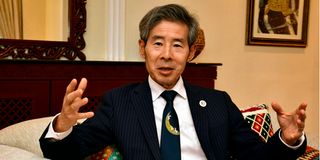Premium
Walk down memory lane commemorating Kenya-Japan friendship

Japanese Ambassador to Kenya, Ken Okinawa, gestures during an interview at Serena Hotel in Nairobi on December 08, 2023.
What you need to know:
- In 1964, the Government of Japan appointed Toshio Urabe as its first ambassador to Kenya and opened its Mission in Nairobi.
- In 1979, diplomatic relations between Japan and Kenya were further cemented with the opening of the Kenyan Embassy in Tokyo.
Yujo is a Japanese word meaning friendship. This is what Japanese Ambassador to Kenya, Ken Okaniwa, describes as the nature of the relationship between Kenya and Japan over the last 60 years.
In 1963, Kenya and Japan established diplomatic relations shortly after Kenya declared her independence. Jomo Kenyatta was elected the following year.
The Government of Japan appointed Toshio Urabe as its first ambassador to Kenya and opened its Mission in Nairobi. In 1964, 37 athletes from Kenya participated in the Summer Olympics in Tokyo, for the first time as an independent country. Wilson Kiprugut won Kenya’s first bronze medal in the men’s 800m race.
In 1979, diplomatic relations between Japan and Kenya were further cemented with the opening of the Kenyan Embassy in Tokyo.
As Japan's 20th ambassador to Kenya, Mr Okaniwa takes a walk down memory lane commemorating the friendship built between Kenya and Japan over the last 60 years.
What was your first Kenyan experience?
I climbed Mount Kenya to Lenana Point, which was a very exciting experience since that is the highest mountain I had ever climbed. It is higher than Mount Fuji. Mount Kenya is about 1,500 metres taller than Mount Fuji, which is the tallest mountain in Japan.
In what ways is Kenya similar to Japan?
There is chemistry between our people. We get along very well. We are both very hospitable to visitors. Both are very respectable and ready to help those in need. We also share a love for agriculture.
I have heard amazing stories from JICA volunteers who came to Kenya. I met a Kenyan lady who was from an impoverished background but was very bright. A JICA volunteer sponsored her studies and now she is an MP. Some have even relocated to Kenya to work here.
Japanese people are known for being very punctual. Could the same be said for Kenyans?
The major reason why Kenyans are usually relaxed about time is probably because of the congestion on the roads. It is not possible to be punctual. Even we, the Japanese, cannot be punctual in Kenya. In business or any work, time is money. If that type of thinking becomes more accepted in Kenyan society, then I do not see any reason why Kenyans cannot become as punctual as the Japanese.
What was the plan after Japan established diplomatic relations in Kenya?
In 1974, we established the Japan International Cooperation Agency (JICA) to support various projects in the country. The sectors that JICA has been involved in are very broad.
They range from infrastructure, energy, agriculture, education, health, forestry, peace and stability. The large infrastructure projects we have been a part of include the Ngong Road expansion project, the Mombasa Airport Development and the Olkaria Geothermal project.
We also played a part in establishing KEMRI over 30 years ago. Currently, Kenya is the largest recipient of Japanese aid in the whole of Sub-Saharan Africa. This shows how much emphasis we put into our cooperation with Kenya.
Many Kenyans use Japanese cars. Is this part of the trade agreements between the two countries?
Not really. Trade is completely left to the private sector. The used cars that are running in Kenya are being imported by Kenyans and private companies.
More significantly, Toyota and Isuzu are trying to promote local manufacturing of Toyota cars and Isuzu trucks. We are working with the government to raise manufacturing capacity in Kenya.
How has Japan contributed to Kenya’s education system?
The Ministry of Education of Japan provides the government with scholarships to young Kenyan students. In the last few decades, 350 Kenyan students received government scholarships to study in Japan. We have supported also JKUAT since it was established over 40 years ago.
What projects is JICA currently working on?
In November, the Japanese government decided to support a new laboratory in KEMRI using state-of-the-art equipment. It will raise the capacity of the institute to be able to analyse viruses and also research various diseases.
You mentioned that Kenya and Japan share interests in agriculture. How has this been seen through the friendship of the two countries in the last 60 years?
Japan imports Kenyan tea, coffee and flowers, especially roses. The largest number of roses in Japan come from Kenya. We are also looking to import avocados as well. We do not produce coffee in Japan so we rely on this coffee from Kenya.
In Kenya, we completed the Thiba Dam. We are using it to expand the network of irrigation. We have Japanese experts supporting the promotion of mechanisation of the agricultural sector.
In about 20 counties in Kenya, we are training small farmers to learn how to analyse their markets and make smart decisions about selecting the best crop for the next season. I visited a site in Kitui County where I met with the farmers who had increased their income by two-fold after the training. Their children can now go to university. They can buy motorbikes and power generators.
Rice is a main dish in Japan. Is that why Japan is heavily invested in rice growing in Kenya?
You might have noticed if you ever tried Japanese food, rice is a basic staple. We supported how to produce rice in Mwea and Ahero. We also showed the farmers how to grow rice more effectively, which increases the yield, contributing to the economy. The Kenyan rice is long grain and not sticky. The rice grain that we eat in Japan is shorter grain and sticky. There is a Japanese businessman that grows this type of rice in Migori.
Have you tried sushi in Kenya?
I have had some and it is a little bit different from the sushi in Japan, where it originates from. We try to promote Japanese cuisine as part of our culture. We appreciate the fact that restaurants such as Sushi Mitsuki has positioned itself as an authentic Japanese restaurant. They even bring fish from Japan. The blue economy in Kenya is an untapped sector in Kenya which President Ruto is trying to promote. There is quite a lot to do to be able to create a distribution network.
Are you aware that there is a whole community of Japanese culture and anime lovers in Kenya?
Yes. In the past, the long distance and lack of historical ties kept the two countries too far apart. There is no reason for that to be an issue today because of the internet.
We recently had a Japanese film festival at the embassy, and when I asked the young audience whether any of them wanted to visit Japan, everyone raised their hands.
It is best to avoid travel during summer which starts in July all through to September. The best time is from March to June (Spring), and October to November (Fall). In Spring, a lot of trees have beautiful flowers such as the cherry blossoms.
How would you summarise the last 60 years of this friendship?
Having gone through numerous photographs taken in the last 60 years, I have been reminded of the breadth and the richness of our relationship that goes well beyond government-to-government relations.
In addition to photographs of visits by political leaders and members of the Imperial family, there are pictures of volunteers and JICA experts dispatched to Kenya, working together with their Kenyan colleagues; Japanese academics on regular visits to Kenya for joint research with their Kenyan counterparts; Japanese university doctors and nurses providing healthcare; Japanese individuals supporting marginalised and vulnerable people; and the list goes on.
Japan and Kenya have always supported each other in good times and bad. When the terrible earthquake and tsunami struck Japan in 2011, Kenyans expressed solidarity with the Japanese people. When the pandemic spread, Japan provided cold chain equipment and vaccines, and KEMRI played a key role in the response.





